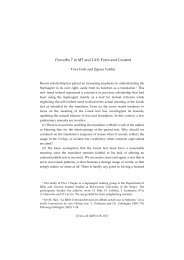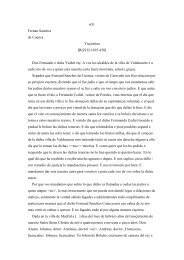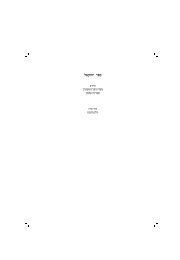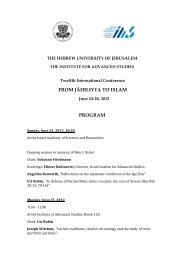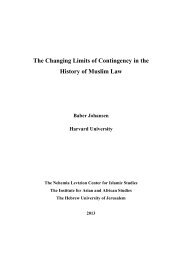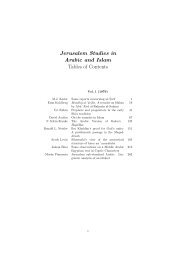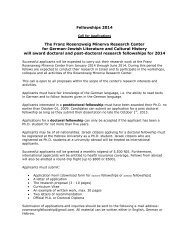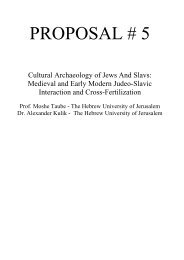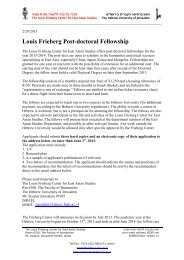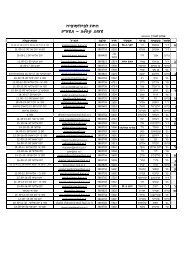THE BOOK OF EZEKIEL Moshe H. Goshen-Gottstein Shemaryahu ...
THE BOOK OF EZEKIEL Moshe H. Goshen-Gottstein Shemaryahu ...
THE BOOK OF EZEKIEL Moshe H. Goshen-Gottstein Shemaryahu ...
Create successful ePaper yourself
Turn your PDF publications into a flip-book with our unique Google optimized e-Paper software.
V. Apparatus III: Medieval Bible Manuscripts<br />
75. An examination of variants in medieval MSS reveals differences almost exclusively<br />
deriving from scribal practices, whether due to linguistic, analogical, or associative factors,<br />
or simply copyists’ errors. By and large their textual value is practically nil. 108 However, the<br />
aforementioned sources are somewhat conspicuous among the hundreds of manuscripts<br />
collated since the beginning of the eighteenth century, since they also contain variants of a<br />
different nature, similar to those found in witnesses of earlier periods. This is especially true<br />
of the five complete manuscripts chosen for collation in the edition, which are characterized<br />
by a particular divergence from the textus receptus both quantitatively and qualitatively. 109<br />
Nevertheless, their variants have no more than a corroborative significance.<br />
Method of Recording<br />
76. All sources were collated anew on the basis of photographs. The variants recorded in<br />
this apparatus concern differences in the consonantal text or in vocalization entailing<br />
significant variants in morphology (conjugation, determination, etc.). Variations in the use<br />
of matres lectiones or reflecting the Babylonian vocalization system (in Genizah fragments)<br />
were not recorded, Obviously, in some instances, the determination whether a reading differs<br />
from ` either orthographically or grammatically is not unequivocal (cf., for example, 29:5<br />
jix`i). On the other hand, even obvious errors in these manuscripts are sometimes noted –<br />
indicated by an exclamation mark (!) – so as to present the reader with a fuller picture. 110<br />
77. This edition of Ezekiel also records differences in sections. It is doubtful whether any<br />
real text-critical significance can be attributed to a differentiation between ‘open’ (petuhot) .<br />
and ‘closed’ (setumot) sections in these sources. Therefore, only differences concerning the<br />
presence or absence of a section were included in the apparatus itself, indicated by the<br />
section symbol (§). A full tabulation of differences including petuhot . (t) and setumot (q),<br />
is given in the appendix to the Introduction.<br />
78. Corrections in the MSS are recorded meticulously by the siglum ‘pm’, which refers to<br />
a reading before it was corrected, and by ‘sm’, which indicates a correction of the text (no<br />
attempt was made, however, to identify a third, or a fourth hand). The siglum ‘sm’ also<br />
refers to cases in which the correction is made by not vocalizing a letter (for example, 34:2<br />
mdil`); ¤ ¨ a lack of vocalization for entire word, however, is indicated by ‘non voc’. Corrections<br />
by the scribe himself in the middle of a word were ignored. However, if the scribe<br />
stopped in the middle of a word without erasing the letters written, the curtailed word was<br />
recorded if it differs from the base text (indicated by ..). Rare cases of a variant readings<br />
entered in the margins of a manuscript (mostly in MS 150) and explicitly marked as `"p (gqep<br />
xg`, “another reading”) or b"i (miqxeb yi, “some read”), are indicated by ‘marg’ (for example,<br />
22:9 l`e).<br />
79. As for ketib/qeri readings, the MSS tend to give only one in the text, usually the qeri<br />
reading. 111 Rare instances in which a manuscript has a qeri reading in the masora parva<br />
108 For this reason the editions of Kennicott, de Rossi, and Ginsberg were not referred to.<br />
109 Cf. <strong>Goshen</strong>-<strong>Gottstein</strong>, “Hebrew Biblical Manuscripts” (above, n. 8), 243–290.<br />
110 Since it is at times impossible to distinguish between similar letters such as i/e, x/c, a/k, we did not<br />
burden the apparatus with such readings. Because our collation is not based on the original<br />
manuscripts, such cases are often marked as dubious by a question mark (?).<br />
111 Ms 96 consistently writes mlyexi according to the qeri perpetuum milyexi. Such differences were not<br />
recorded in the apparatus.<br />
xxxix



